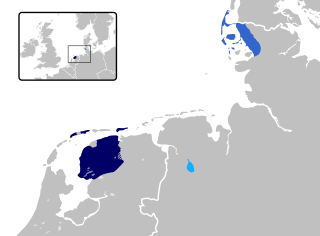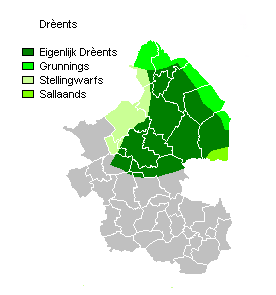
The Frisian languages are a closely related group of West Germanic languages, spoken by about 500,000 Frisian people, who live on the southern fringes of the North Sea in the Netherlands and Germany. The Frisian languages are the closest living language group to the Anglic languages; the two groups make up the Anglo-Frisian languages group and together with the Low German dialects these form the North Sea Germanic languages. However, modern English and Frisian are not mutually intelligible, nor are Frisian languages intelligible among themselves, owing to independent linguistic innovations and foreign influences.
The Frisians are an ethnic group indigenous to the coastal regions of the Netherlands and northwestern Germany. They inhabit an area known as Frisia and are concentrated in the Dutch provinces of Friesland and Groningen and, in Germany, East Frisia and North Frisia. The name is probably derived from frisselje. The Frisian languages are spoken by more than 500,000 people; West Frisian is officially recognised in the Netherlands, and North Frisian and Saterland Frisian are recognised as regional languages in Germany.

Frisia is a cross-border cultural region in Northwestern Europe. Stretching along the Wadden Sea, it encompasses the north of the Netherlands and parts of northwestern Germany. The region is traditionally inhabited by the Frisians, a West Germanic ethnic group.

Weststellingwerf is a municipality in the province of Friesland in the northern Netherlands. It is one of the municipalities of Friesland, where the spoken language is not West Frisian; instead, Stellingwerfs, a dialect of Dutch Low Saxon, is spoken here.
East Frisian Low German or East Frisian Low Saxon is a Northern Low Saxon dialect spoken in the East Frisian peninsula of northwestern Lower Saxony.
Westphalian or Westfalish is one of the major dialect groups of Low German. Its most salient feature is its diphthongization. For example, speakers say iäten instead of etten or äten for "to eat".

West Frisian, or simply Frisian, is a West Germanic language spoken mostly in the province of Friesland in the north of the Netherlands, mostly by those of Frisian ancestry. It is the most widely spoken of the Frisian languages.

Hollandic or Hollandish is the most widely spoken dialect of the Dutch language. Hollandic is among the Central Dutch dialects. Other important language varieties of spoken Low Franconian languages are Brabantian, Flemish, Zeelandic, Limburgish and Surinamese Dutch.
Dutch Low Saxon are the Low Saxon dialects of the Low German language that are spoken in the northeastern Netherlands and are written there with local, unstandardised orthographies based on Standard Dutch orthography.

West-Veluws is a Low Franconian dialect of the Dutch province of Gelderland. It is spoken in several Veluwe municipalities and villages including: Nunspeet, Putten, Ermelo (Armelo), Harderwijk (Harderwiek), Uddel, Nijkerk (Niekark), Appel, Scherpenzeel (Schaarpezeel), the municipality of Barneveld (Barreveld) and some villages of the municipality of Ede.
Johan Veenstra is an author, poet, columnist and former radio host from the Dutch province Friesland known for his work in his mother tongue Stellingwervian Low German, for which he was invested as a Knight of the Order of Orange-Nassau.
Sallaans is a collective term for the Westphalian dialects of the region Salland, in the province of Overijssel, as well as in minor parts of Gelderland and Drenthe in the Eastern Netherlands, and a small part in the North and the East of Veluwe.. In the Kop van Overijssel, the Stellingwarfs dialect is spoken.

The predominant language of the Netherlands is Dutch, spoken and written by almost all people in the Netherlands. Dutch is also spoken and official in Aruba, Bonaire, Belgium, Curaçao, Saba, Sint Eustatius, Sint Maarten and Suriname. It is a West Germanic, Low Franconian language that originated in the Early Middle Ages and was standardised in the 16th century.

Appelscha is a village in the municipality of Ooststellingwerf in the province of Friesland, Netherlands. It has just under 4,800 inhabitants.

Peperga is a small village in Weststellingwerf in the province Friesland of the Netherlands. As of 2017, it has a population of 85 people, living in approximately 35 houses, and is characterized by detached houses, several businesses and a church. Peperga is located on the A32 between Wolvega and Steenwijk, with public transportation offering a service to the nearby villages of Steggerda and De Blesse.

Drèents is a collective term for Westphalian dialects spoken in Drenthe, a province of the Netherlands. They are spoken by about half of the population of the province.
Dutch dialects are primarily the dialects that are both cognate with the Dutch language and spoken in the same language area as the Dutch standard language. They are remarkably diverse and are found within Europe mainly in the Netherlands and northern Belgium.
A grietenij was a municipal district, a forerunner to the gemeente or municipality in Frisia, particularly in Friesland, and also in the city Groningen which are now a part of the Netherlands. After the Saxon occupation, from about 1498 until 1851, there were a total of 30 grietenijen in Friesland and 11 cities.

Friso-Saxon is a group of West Germanic dialects found around the North Sea coast of the Netherlands and Germany, in an area historically known as Frisia. They are dialects of Low German/Low Saxon that have experienced strong influence from a Frisian language.
Dutchification is the spread of the Dutch language, people or the culture of the Netherlands, either by force or cultural assimilation.










